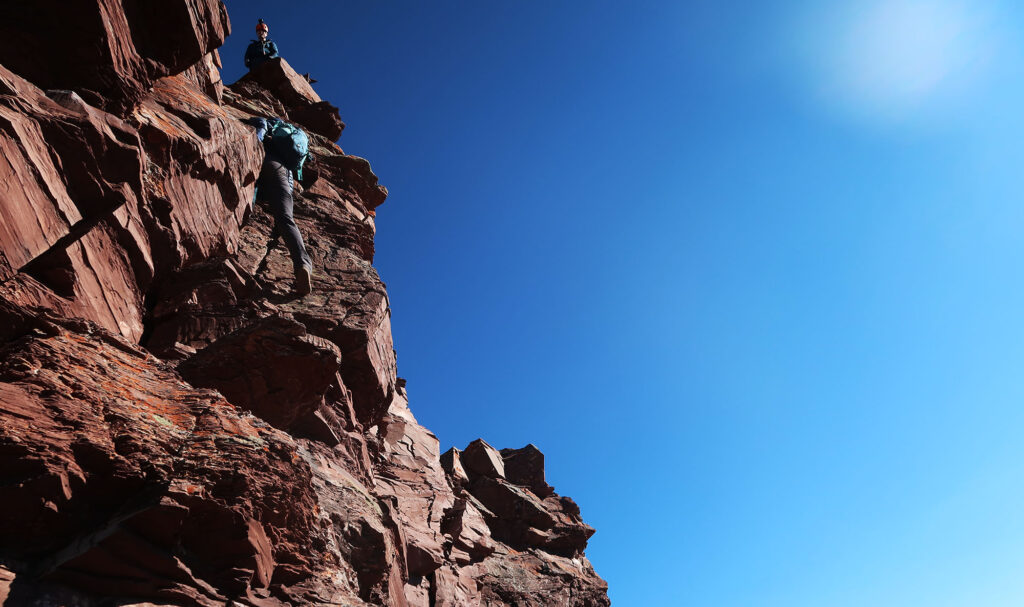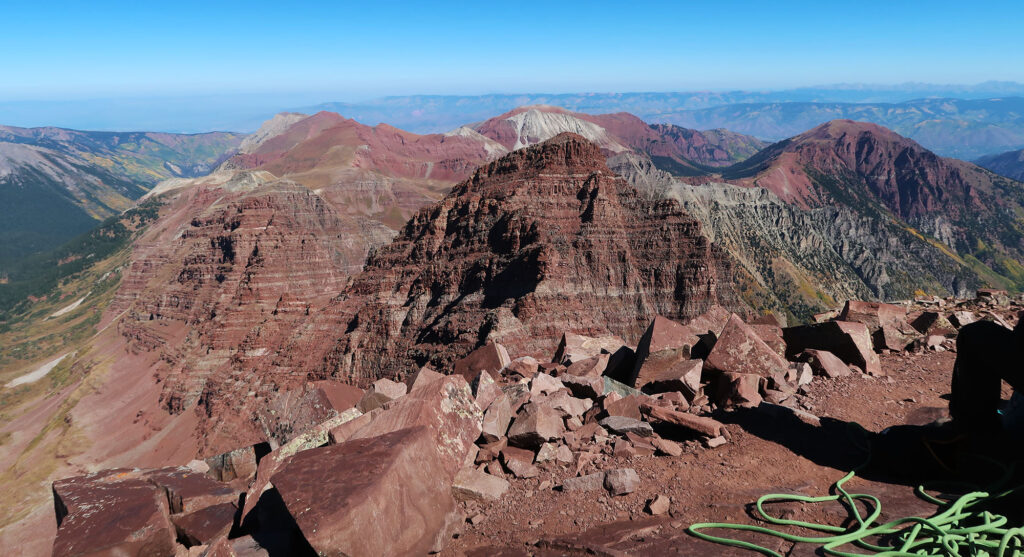September 25, 2021
First Attempt: June 2021
Our “day” began around 1:30 am. Yes, you read that right. The forecast called for unstable weather in the Elk Mountains that afternoon. And so my guide advised we meet in the parking lot at Aspen Highlands before the bars in town had even closed.
After a quick gear check, we drove up to Maroon Lake. We arrived to find the extraordinarily popular hiking and photo destination deserted. We donned headlamps and trudged up from Maroon to Crater Lake, a roughly 700-foot ascent through the Valley deep below our target summits. A fullish moon popped in and out of cloud cover. Throughout the ascent, we would pass through cloud and fog layers. The air felt saturated with moisture.

A couple of miles later, we reached the end of our sojourn on the popular Maroon Pass hiking trail. The backpacking route had led us many miles away from the parking area, back behind the Maroon Bells themselves. While we had gained roughly 1500 feet, the “real climb” was only about to begin.
The “standard route” up South Maroon snaked its way up an extremely steep slope of green bushes and thicket. The next 2000 vertical feet (roughly two empire state buildings) would involve pushing up this monotonous, exposed ramp of scree and vegetation. My guide referred to this section by its popular moniker: “The Green Monster”. We hiked through a cloud layer or two. I find it hard to overstate how wet and cold this adventure would prove. My jacket grew soaked as it brushed against endless dew-laden bushes.

The Deadly Bells
Colorado sports roughly 58 prominent peaks topping out over 14,000′ above sea level. At some point, after moving to the Centennial State, I decided I would try to summit each of them.
A solid majority of these 14ers are just … well … hikes. Don’t get me wrong: they’re not a walk in the park. You ascend the equivalent of four to five Empire State Buildings. You do it with half the oxygen. If a storm rolls in, the nearest tree canopy or structure may be many miles away. But for most of these peaks, tripping over your feet won’t kill you.

The Maroon Bells present a stark exception to this rule. Steeper 14er ascents exist—particularly if you start straying from “standard” routes. But the Bells present a somewhat unique combination of steep, exposed climbing on loose, crumbling rock. People literally die on these peaks.
Plenty of folks still decide to climb these bad boys in little more than shorts and chacos. But I decided to hire a guide.

Aside from keeping me alive, hiring a guide came with another big upshot. Rather than tackle these peaks separately, I could string them together via the Maroon Bells Traverse. This would graduate the journey from a Class IV outing to a Class V climb: with stints of full-on rock climbing.
Into the Clouds
Eventually, we topped out on the ridgeline, round 13,000′. We had just 1200 vertical feet and under a mile of straight-line distance left. But my guide assured me, it would take a couple of hours. The helmets and harnesses came on. The headlamps went away.
A stormy spring meant ample patches of snowpack remained on the airy ridgeline. The same precipitation that had endowed the bushes below with dewdrops had left a thin layer of ice on the rocks up here. For some odd reason, neither of us thought to don our microspikes until after summitting.

I slipped a few times on icy rock. But always caught myself. A couple of times we peeled off the solid rock parapets and crawled up gullies of loose, crumbly ball bearings. I could feel the rocks beneath my feet shift downward as I climbed upward. It felt a bit like a video game. The powers that be say South Maroon is a Class III ascent (North Maroon is Class IV). But that doesn’t convey how loose, crumbling, and exposed the route really is.
South Maroon and a hard decision
Eventually, we reached the summit. Now we were truly inside a cloud. I could see perhaps 10 feet in any given direction. We had a decision to make. We could attempt the traverse to North Maroon, or turn around and head back. At some point, the forecast called for downpour rain. I thought about roped, technical climbing at 14,000′ in a downpour. It didn’t sound particularly safe. The weather seemed precision-tuned to present as miserable as possible: warm enough to rain, but just barely.
We made the call to head back down. We would return for North Maroon and the Maroon Bells Traverse another day.
As if to spite us, the weather began to rapidly clear as we approached 13,000′. I caught a glimpse of the peak we just left. Further afield, I could see deep into the lush, beautiful Maroon Bells-Snowmass Wilderness.


Redemption in September
To date, I have summited 17 Colorado 14ers (North Maroon makes #17). I have thrice been turned around on one of these missions. Once we attempted Bierstadt in April after a foot of fresh snow. Just 300′ shy of the summit, my buddy had a pair of intense asthma attacks. Once I attempted Pikes Peak right after starting a rough, new medication. And the June attempt at the Maroon Bells Traverse was failed attempt #3.
It really sucks missing an objective. But I’ve found the second attempt always proves worth the wait. In this case, it meant experiencing the Bells at peak Fall foliage!

We started from the lake around 4 am this time. This time mother nature was on our side. She had endowed the Elk Mountains with warm, dry air and clear blue skies. With three more months of peak bagging under my belt, I also found the ascent far less taxing.
We opted to ascend North Maroon this time and do the Maroon Bells Traverse in both directions. This meant avoiding the dreaded “Green Monster” and the chossy slopes of South Maroon. It also meant more time on technical rock.
North Maroon
The “key col” between North and South Maroon lies under 300 vertical feet from North Maroon’s summit. This means North Maroon does not count as a “true” 14er. But by tradition, peak baggers collect this summit anyways along with three other ‘fake’ peaks.
North’s ascent rates a grade higher than South’s at “Class IV”. I honestly couldn’t tell you what makes a route III vs IV. That said, I found North Maroon way less frightening. The rock proved more solid. And despite a few near-vertical sections, I didn’t feel horrifically “exposed”. All that said, I had experienced a summer of rock climbing and peak bagging between the two ascents. So shifting perceptions could be at work.

The Maroon Bells Traverse
At long last, we came to the main event: the Maroon Bells Traverse. The two peaks sit less than 2000 feet apart, as the crow flies. But the jagged, exposed ridge would take us a whopping four hours to traverse in both directions.

The rock proved relatively solid. Most folks perform the traverse from South-to-North, and that means traveling up the majority of Class V sections. Going North-to-South meant “downclimbing” these routes. None were long enough to make it worth a rappel. And the rock quality meant “fixed anchors” were rarely a smart move. So instead I would turn to face the rock and step down along ledges and handholds. My guide would find a way to anchor himself above. Then I would find somewhere steady to plant myself, and he’d come down (far more assuredly). We alternated like that many times.

I found the Bells Traverse to be pure enjoyment! The exposed, technical traverse kept my full attention from start to finish. I never felt tired or exhausted or uncomfortable. The ratio of mental to physical exertion skewed heavily towards the former.

Eventually, we reached South Maroon. I sat in the warm sun and ate a few snacks and surveyed the 360-degree views. What a contrast to our last summit! Then in short order, we did the whole traverse again in reverse. I vastly preferred this to the South Maroon descent.

Back Down to Earth
The traverse seemed much easier on the return trip. I’m probably not alone in saying I prefer ascending a rock wall to descending. Feeling more confident, I was able to survey the gorgeous Fall scenes below me on either side.




We descended North Maroon. After what felt like an eternity we were back down at Crater Lake. Now we joined the throngs of less-insane adventurers trekking beneath the golden aspens between the two gorgeous alpine lakes.



